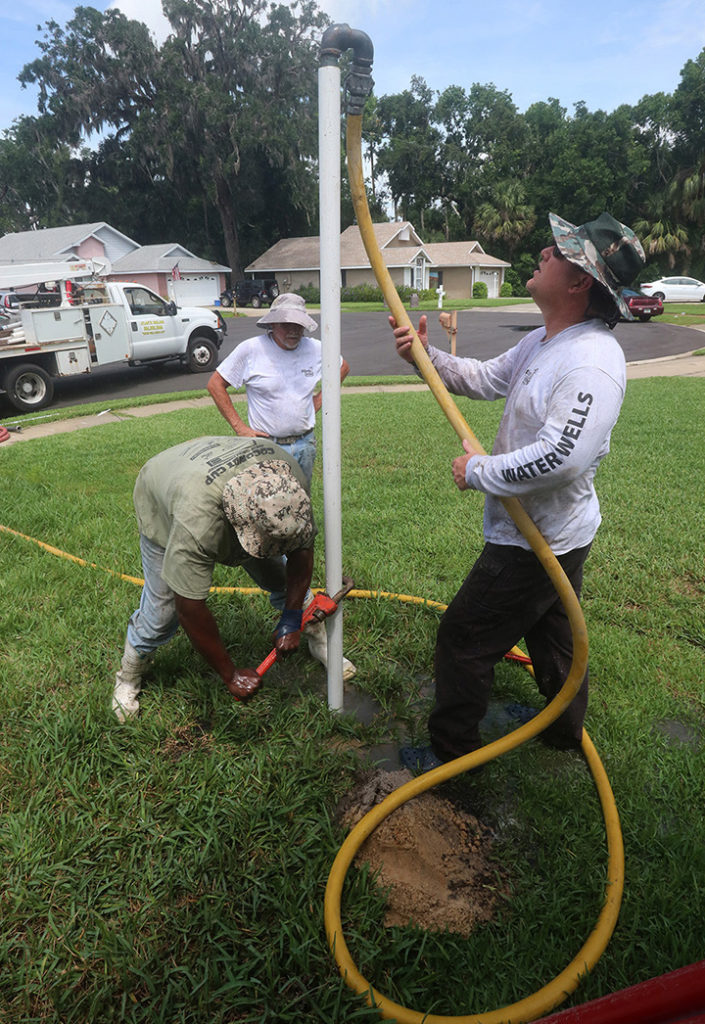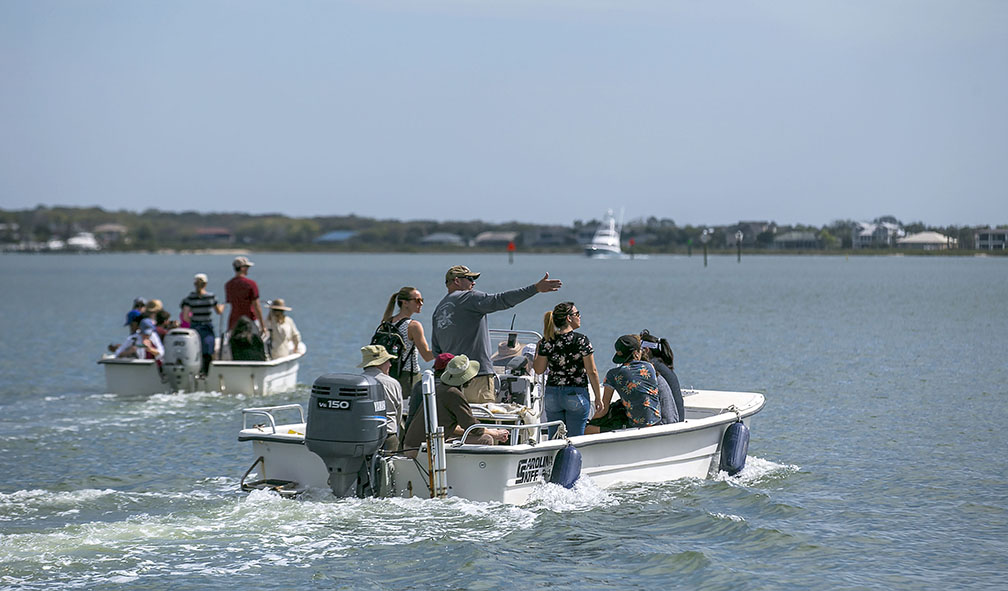Salud, Alcadessa!
Salt water creeps inland
By Cindy Swirko, cindy.swirko@gvillesun.com
When Arnoldo Valle-Levinson asks St. Augustine residents what they think of saltwater intrusion, he’s often met with eyes as glassy as the Atlantic on a calm morning.
The term may be off the radar of some coastal residents but the process is happening, will accelerate and will cause expensive headaches for cities with water systems and for homeowners with wells.
“Municipalities should start preparing, and the way you start preparing is by understanding what is happening now and what can happen,” said Valle-Levinson, a professor in the University of Florida’s Civil and Coastal Engineering Department.
“I ask people in St. Augustine, ‘Do you worry about saltwater intrusion?’ They are not paying attention to it. When they start getting brackish water in their wells or in the city’s water supply, it’s going to be too late. They will not be able to act quickly.”
Salt water can creep into the aquifer during droughts that deplete fresh water, allowing the salty liquid to flow in. It can also invade the aquifer when too much fresh water is pumped out.
But the saltwater intrusion the experts say is inevitable for Florida’s coasts will be far more extensive and more expensive.
Salt water is heavier than fresh water. As the Atlantic and the Gulf of Mexico rise higher, salt water will push its way into the aquifer and then overtake the fresh water.
It will also push farther up rivers such as the St. Johns and Suwannee, changing their ecosystems and in some cases flowing into freshwater springs.
Already, salt water can sometimes be detected in the St. Johns at Palatka. That will become far more frequent.
Saltwater intrusion began years ago in wells along the coast of Volusia and Flagler counties. Salt water intruding into shallow wells used for irrigation means the wells, in some cases, can no longer be used to water lawns or shrubs.

The deep wells on the northern peninsula of Volusia County, around Ormond-by-the-Sea also have salt in them, Watkins said. It doesn't appear to be migrating, he said, "but I think maybe where it is, it may be getting a little stronger."
Some coastal utilities in St. Johns River Water Management District’s 18-county region already are experiencing increased salinity in their public supply wells, said spokeswoman Teresa Monson said.
To address the challenges, Monson said the district is coordinating with the Florida Climate Institute and the Florida Water and Climate Alliance.
“We have seen water quality become more mineralized primarily in coastal areas but also in some interior areas,” she stated. The intrusion or the upward movement of highly mineralized water into layers of fresh water has occurred in areas where there has been “excessive pumping at agricultural wells and public supply wellfields.”
In the Panhandle, meanwhile, the Northwest Florida Water Management District is not concerned about saltwater intrusion. District Executive Director Brett Cyphers said the district has not spent a lot of time researching potential impacts of sea level rise on the aquifers relied upon for fresh water.
“We don’t have the same level of saltwater intrusion other areas have,” said Cyphers, who oversees a district that stretches across Florida’s Panhandle from Escambia to Jefferson County. “From a resource perspective we’re not going to have the pressures. The terrain here is different. Water flows downhill. We have elevations. Where the land sits flat the water moves slower.”
In the rest of Florida, however, cities are taking notice.
Some cities have installed reverse osmosis systems in their municipal utilities. Among them are Cedar Key, Clearwater, Cape Coral and Jupiter. In reverse osmosis, water is forced through membranes that remove salt.
Utilities officials say their brushes with saltwater intrusion have given them foresight into the future and what will be needed as Atlantic and Gulf. It will come at a cost.
Cedar Key installed a reverse osmosis system in 2012 when saltwater intrusion was caused by drought.
John McPherson, general manager of the Cedar Key Water and Sewer District, said the wells are 200 feet deep and several miles inland of the island off State Road 24. The district provides water to the island but is independent of Cedar Key city government.
McPherson said the reverse osmosis system is used only when salt water contaminates the well. The organic elements in fresh water make the system less efficient, so it is not run full-time.
The wells are currently as deep as they can be — salt water lies below 200 feet — so digging deeper is not an option for future intrusion caused by sea level rise.
That means the reverse osmosis system will be pressed into service more often, driving up the cost of fresh water.
“It does cost more. When you put 100 gallons into a reverse osmosis system, 20 gallons gets discharged as waste. And that’s if everything is working properly,” McPherson said. “And there are additional electrical costs. But it’s a mechanical solution we have already paid for.”
Clearwater is taking a different, and more innovative, approach to future saltwater intrusion.
Both of the city’s two reverse osmosis plants were installed without regard to seawater intrusion, said David Porter, director of Clearwater Public Utilities.
One was built because one of the city’s wells developed higher levels of arsenic in the water that had to be removed. The other was built because the amount of water available for new capacity in the fresh water zone of the aquifer is limited.
But recognizing that saltwater intrusion is expected to rise with sea levels, Clearwater is the first utility in Florida implementing a groundwater replenishment system to clean used water to potable standards. Permits are being issued now and construction is expected to begin late this year or in early 2019.
“We are taking highly treated effluent from our wastewater treatment plant that is already being used for reclaimed water. We are going to put it through an entirely new advanced water purification facility. It’s very, very advanced,” Porter said. “It will be better than drinking water quality and we are going to inject it into the lower Floridan zone. That is going to raise the pressure of the aquifer to combat saltwater intrusion and to provide more water in the upper zone for people to use.”
Extensive testing was done before Clearwater signed on for the $33 million project, which is partially funded by the Southwest Florida Water Management District.
Valle-Levinson said more coastal public water suppliers, and homeowners with their own taps in the aquifer, will have to account for saltwater intrusion in the future. It won’t be cheap.

Even inland areas are expected to be affected, including communities along the St. Johns River. The intrusion could be even more severe if the river is dredged deeper at the city’s port to accommodate larger ships. That will enable more seawater to flow in and travel farther upriver to Palatka and beyond.
As more public utilities face saltwater intrusion, the technologies used to cope with it will likely evolve. Reverse osmosis is one type of desalination technology but other exist including various methods of distillation of salt water.
Unless massive amounts of rain can recharge the aquifer or large amounts of rainwater can be stored, saltwater intrusion is going to happen along the coasts, Valle-Levinson said.
“The estuaries will be salinated. The aquifer will be salinated,” Valle-Levinson said. “The most basic resource that we need — fresh water — will be contaminated, but also all of our infrastructure. Salt water will start corroding our sewage, our drainage, our communications, our vehicles. The problem of saltwater intrusion is super important. We hear about it, but we don’t hear about it enough and I don’t think there is a concerted effort to address the problem.”
Dinah Voyles Pulver of the Daytona Beach News Journal and Tom McLaughlin of the Northwest Florida Daily News contributed to this report.
No comments:
Post a Comment